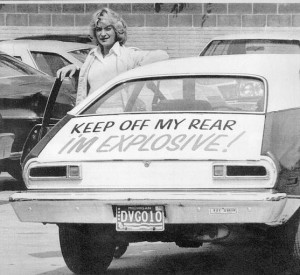I love Valentine’s Day. It’s not that I’m a romantic, but that most years it was an excuse to get drunk, and last year a dude even ran through my Calculus class in nothing but a diaper and wings. Valentine’s Day is always a hoot.
.jpg) This year I’ve spent time in candy aisles rather than calculus lectures, scanning for recalled Valentine’s chocolate linked to the current Salmonella outbreak. As I wrote in bites,
This year I’ve spent time in candy aisles rather than calculus lectures, scanning for recalled Valentine’s chocolate linked to the current Salmonella outbreak. As I wrote in bites,
With over 600 ill and 9 deaths linked to peanut paste produced by the Peanut Corp. of America, consumers may opt to give flowers rather than sweets on February 14. Of the 2000 peanut products recalled, over 670 contain chocolate. The popular peanut-chocolate combination is found in chocolate trays, bars, snack mixes, cookies, pies, and more, all examples of recalled products, and all popular Valentine’s gifts.
The Walgreens pharmacy and Wal-Mart superstore in Manhattan, Kansas, both featured prominent Valentine’s Day displays during the past week. Aisle after aisle was stocked with pink and red packaged peanut-chocolate treats, but nowhere was there mention to the safety of these items. A concerned consumer wishing to purchase these must either scan the 68 pages of chocolate products recalled on the FDA website, or trust that potentially contaminated products have been removed from store shelves. But with the recall list growing daily, consumers may find it difficult to assume the chocolate-covered peanuts that are safe today won’t be added to the recall list tomorrow.
Keith Warriner, a food microbiologist at the University of Guelph in Canada, explained last week via email, the concerns associated with Salmonella in chocolate products. “Because chocolate is high in fat it protects Salmonella from environmental stress and stomach acid,” said Dr. Warriner. “So in effect, if chocolate does become contaminated, Salmonella survives longer and only needs to be present in low numbers to survive passage through the stomach.”
 Chocolate is a not uncommon vector for Salmonella. In 2006 both Cadbury and Hershey brand chocolate products were associated with separate Salmonella contamination. Cadbury recalled over 1 million chocolate bars in the UK after more than 40 consumers were sickened, and 3 were hospitalized due to Salmonella contamination from poor plant sanitation. A few months later, Hershey Canada recalled candy products due to possible Salmonella contamination, and though there were no reported illnesses, some of this recalled Hershey product re-entered the marketplace two years later.
Chocolate is a not uncommon vector for Salmonella. In 2006 both Cadbury and Hershey brand chocolate products were associated with separate Salmonella contamination. Cadbury recalled over 1 million chocolate bars in the UK after more than 40 consumers were sickened, and 3 were hospitalized due to Salmonella contamination from poor plant sanitation. A few months later, Hershey Canada recalled candy products due to possible Salmonella contamination, and though there were no reported illnesses, some of this recalled Hershey product re-entered the marketplace two years later.
Though I didn’t see any of the recalled products while shopping, it’s hard to be certain none were missed with over 670 products being recalled. I also didn’t see any signs informing consumers about the safety of the sweets in these aisles. If a store is confident recalled peanut-products have been removed from shelves, a way to help out consumers is putting up some signs in the aisles.
 In a statement posted on its website on July 12, the firm further guaranteed that they have met all the needed food safety requirements in the countries where they exported their products.
In a statement posted on its website on July 12, the firm further guaranteed that they have met all the needed food safety requirements in the countries where they exported their products.


 within arm’s reach, I jam it in my mouth.
within arm’s reach, I jam it in my mouth.
 We here at barfblog.com continually advocate keeping as much poop out of food as possible, and proudly wear our
We here at barfblog.com continually advocate keeping as much poop out of food as possible, and proudly wear our 
.jpg) This year I’ve spent time in candy aisles rather than calculus lectures, scanning for recalled Valentine’s chocolate linked to the current Salmonella outbreak. As I wrote in
This year I’ve spent time in candy aisles rather than calculus lectures, scanning for recalled Valentine’s chocolate linked to the current Salmonella outbreak. As I wrote in  Chocolate is a not uncommon vector for Salmonella. In 2006 both Cadbury and Hershey brand chocolate products were associated with separate Salmonella contamination. Cadbury recalled over 1 million chocolate bars in the UK after more than 40 consumers were sickened, and 3 were hospitalized due to Salmonella contamination from poor plant sanitation. A few months later, Hershey Canada recalled candy products due to possible Salmonella contamination, and though there were no reported illnesses, some of this recalled Hershey product re-entered the marketplace two years later.
Chocolate is a not uncommon vector for Salmonella. In 2006 both Cadbury and Hershey brand chocolate products were associated with separate Salmonella contamination. Cadbury recalled over 1 million chocolate bars in the UK after more than 40 consumers were sickened, and 3 were hospitalized due to Salmonella contamination from poor plant sanitation. A few months later, Hershey Canada recalled candy products due to possible Salmonella contamination, and though there were no reported illnesses, some of this recalled Hershey product re-entered the marketplace two years later. So I was horrified to read that
So I was horrified to read that 
 The U.K. Food Standards Agency said today
The U.K. Food Standards Agency said today The trial, at the University of East Anglia in Norwich, eastern England, will test whether a natural compound found in cocoa, the main ingredient of chocolate, could cut the risk of heart disease among women with diabetes.
The trial, at the University of East Anglia in Norwich, eastern England, will test whether a natural compound found in cocoa, the main ingredient of chocolate, could cut the risk of heart disease among women with diabetes. The
The